Read Reviews
The Best Palm Routers
-
Best budget palm router - Katsu Electric Hand Trimmer Wood Router
-
Best brushless palm router - Makita DRT50ZX4 Cordless Router Trimmer
-
Best palm router with bits included - DEWINNER Electric Palm Router Set
-
Best lightweight palm router - Bosch Professional GKF 12 V-8 Cordless Router
-
Best for professionals - Makita RT0700CX4 240 V Router/Trimmer
-
Best palm router for performance and value - VonHaus Compact Palm Router
-
Best palm router for power - DeWalt D26200 Compact Fixed Base Router
-
Best cordless palm router for beginners - Ryobi R18TR-0 ONE+ Cordless Trim Router
Palm Router Reviews
1. Katsu Electric Hand Trimmer Wood Router
Best budget palm router
- The same speed range as the Makita RT0700CX4. 10,000 – 30,000 rpm is great for such a budget model.
- There’s a huge range of spares and accessories available from Makita that fit this palm router perfectly. You can expand your collection with quality parts without overspending.
- The aluminium motor body feels great. There’s a lot less plastic compared with the much more expensive Ryobi R18TR-0.
- At just 2.5 kg, this is a lightweight palm router that punches above its weight. Don’t be fooled, it’s got plenty of power!
- Compared to the DeWalt D26200’s 55 mm maximum cut depth, the Katsu’s 20 mm is tiny. It’s fine for light jobs, but you need more range if you want to tackle anything heavier.
- For the money, you can’t expect a brilliant soft start motor. There’s a bit of a kick if you start the router at a high speed.
- The rack and pinion adjust mechanism is a bit rough compared to the Makita DRT50ZX4. The quality of finish on the moving parts isn’t as refined.
- Corded/Cordless
- Corded
- Power
- Mains - 710W
- Variable Speed
- Yes
- No-Load Speed
- 10,000-30,000rpm
- Max Collet Size
- 1/4"
- Max Plunge Depth
- 20mm
- Weight
- 2.5kg
- Collets Supplied
- 1x1/4", 1x3/8"
- Build Quality
- 4.5
- Performance
- 4.5
- Ease of use
- 4.5
- Value for Money
- 5
Katsu tools offer a surprising level of build quality and reliability for a brand you may never have heard of. I got hold of their electric wood trimmer and think it’s one of the best budget palm routers you can get for the money.
With a 710 Watt motor, it’s a remarkably similar tool to the best palm router on our list, the Makita RT0700CX4. In fact, it even takes the same spare parts and fits the same accessories. If you’re not bothered about name brands this is an excellent choice to make.
It’s not as refined in comparison with the more expensive palm routers on our list, but for the price, you can forgive this little beast. It uses the same rack and pinion depth controls as the Makita and it’s easy to change out the bits. Even though it has a brushed motor, they include carbon replacements.
Did you find this review helpful?
2. Makita DRT50ZX4 Cordless Router Trimmer
Best brushless palm router
- All the power of the RT0700CX4. None of the cords. It’s a joy to use it hands free.
- The soft touch buttons are easy to see and won’t get clogged up with dust.
- Unless you add a huge high Ah battery, this is an ultra-lightweight router. Using it one handed isn’t a problem.
- The soft start is just that. There’s barely any kick and the cutting bit stops quickly after turning off too.
- The lack of LED work light is a bit of a shame. Maximum visibility is essential for accurate routing.
- Unless you fork out for high Ah batteries, this router won’t last all day. Routing is energy hungry, so make sure you have spares!
- Some users have complained that there’s not much room for wide diameter router bits. Anything over 25 mm is a tight fit inside the base plate opening.
- You might find the base plate is rather small. Even though a small footprint is useful, it’s also not as stable.
- Corded/Cordless
- Cordless
- Power
- Battery - 18V
- Variable Speed
- Yes
- No-Load Speed
- 10,000-30,000rpm
- Max Collet Size
- 3/8"
- Max Plunge Depth
- 40mm
- Weight
- 2.1kg
- Collets Supplied
- n/a
- Build Quality
- 5
- Performance
- 4
- Ease of use
- 5
- Value for Money
- 4
Cut from the same quality cloth as the best palm router on our list, Makita’s DRT50ZX4 is a brushless cordless trimmer that gives you all the power you need without the cord to trip over. This little beast forms part of Makita’s excellent LXT range of Lithium-Ion powered tools. You can share the batteries from your drill or saw to power up this palm router, making it brilliantly versatile.
First off, you get a solid aluminium case that holds the 18V-powered brushless motor. There are five selectable speeds from 10,000 – 30,000 rpm and a cutting depth of up to 40 mm with the supplied trimmer base. The start button is illuminated and can be locked on with another soft-touch button next to it as well, rather than the standard rocker switch.
In terms of operation, the DRT50 is almost identical to the corded Makita RTO7, but you have the advantage of being able to use it on-site or away from a power source. It does feel a little bit top-heavy with a battery connected though, especially if you’re using a high Ah one. Also, be aware that this is a “bare” palm router- you’ll have to buy an 18V battery separately.
Did you find this review helpful?
3. DEWINNER Electric Palm Router Set[ SAVE 3% ]
Best palm router with bits included
- This is the only palm router on my list that comes with router bits to get you started. Even though they’re only basic ones, it’s great to have spares or something to practice with.
- The blisteringly fast top speed blows all the other routers on my list out of the water! 33,000 rpm no load speed might not be ideal for every job, but it’s good to know it can get there.
- Like the VonHaus router, you get some useful rubberised plastic patches on the router collar. This makes it comfortable to hold and fine to use with one hand.
- I usually recommend buying decent quality router bits. They can transform a very ordinary machine into something that produces professional results. The included bits aren’t great.
- Several users have complained that this router produces excess vibration. Unless the collar is properly tightened, it can work loose and change the router depth unexpectedly.
- Corded/Cordless
- Corded
- Power
- Mains - 710W
- Variable Speed
- Yes
- No-Load Speed
- 13,000-33,000rpm
- Max Collet Size
- 3/8”
- Max Plunge Depth
- 20mm
- Weight
- 2.3kg
- Collets Supplied
- 1x1/4", 1x3/8"
- Build Quality
- 3
- Performance
- 4
- Ease of use
- 3
- Value for Money
- 4
Budget tool brand DEWINNER have worked out a clever way to make decent quality power tools at remarkable prices. Their electric palm router set is ideal for someone who’s just starting out on their woodworking journey. It includes everything a budding DIYer will need to try out one of the most versatile tools out there.
The unit is similar in its construction to the Katsu and VonHaus palm routers. You get a sturdy plastic case that holds the motor and an aluminium shaft and collar that can be adjusted with a small wheel. The cutting depth is locked in with a lever and you can switch out bits with a small spanner.
There’s a 710 Watt motor on board that can spin ¼” or 3/8” shank bits up from 13,000 to a maximum of 33,000 rpm. Its speed-adjustable as well by turning the wheel on top. DEWINNER have included the normal accessories such as a straight and curved guide, but they’ve gone a bit further than the competition.
What I really like about this palm router set is the five included bits because you can get to work straight away. You get a pair of different diameter straight cut bits, a guided straight cut bit, a cove bit, and a round over bit. Not bad for the price!
Did you find this review helpful?
4. Bosch Professional GKF 12 V-8 Cordless Router
Best lightweight palm router
- You can work above your head, horizontally or vertically, and not get tired quickly. This is the best lightweight palm router for awkward jobs.
- It’s different. Designed to be used one-handed, Bosch have reinvented the grip and made it seriously easy to use.
- The grippy sections on the router base show you exactly where to pile on the pressure. It’s an easy tool to keep steady.
- Bosch’s brushless motor makes the most of the 12 Volt battery system. It’s efficient and you won’t ever have to change brushes.
- I like the cleverly-designed spindle lock. Rather than holding down a little button, a large red tab pulls out and locks the spindle into place. You could, in theory, change bits one handed!
- This router is best used for edge trimming. It’s not designed for heavy duty routing jobs.
- To get the maximum life from this router, you’ll need the 4 Ah battery. Unfortunately, it will spoil the balance and lose the streamlined look.
- If you’ve got large hands, like me, you’ll find the fine depth adjust wheel a bit of a pain. When you get close to the base plate there’s barely enough room to adjust it.
- I was a bit disappointed that this router doesn’t come with a variable speed control. 13,000 rpm might not be enough for some jobs.
- Corded/Cordless
- Cordless
- Power
- Battery - 12V
- Variable Speed
- No
- No-Load Speed
- 13,000rpm
- Max Collet Size
- 1/4"
- Max Plunge Depth
- 36mm
- Weight
- 1.3kg
- Collets Supplied
- 1x1/4"
- Build Quality
- 5
- Performance
- 4
- Ease of use
- 5
- Value for Money
- 3
No list of the best palm routers would be complete without a Bosch Professional router. The GKF 12V-8 is a radical re-design of the standard shape palm router and forms part of Bosch’s “blue” line of professional 12 Volt tools. This means it’s made with professional users in mind and will be robust, reliable, and ready for anything.
You might not recognise the shape of this palm router. It’s a bit different in design, but the shape makes it comfortable for one-handed use. It’s been designed for one main job – shaping and trimming edges – and it does so quickly and comfortably.
Taking its power from a 12V Lithium-Ion battery, the GKF means you can work at any angle or in any place without worrying about tripping over cables. It’s ideal for working above your head or in awkward spots. It’s incredibly light at just over 1 kg, compared to other palm routers like the DeWalt D26200.
The fact that it’s a lightweight 12V tool means there’s a bit of a compromise though. You only get a maximum 13,000 rpm; you can’t add any other bases and it’s no use for heavy-duty trimming jobs. If you want an ultra-portable tool, this is the best palm router for light duty use.
Did you find this review helpful?
5. Makita RT0700CX4 240 V Router/Trimmer
Best for professionals
- Don’t be fooled by this palm router’s light weight. The powerful 710 Watt motor is more than capable for most DIY jobs.
- The top of the router is flat. This makes bit changes incredibly easy. Compared to the Bosch GKF, it’s child’s play.
- The included trimmer guide is made from quality materials. It makes following curved edges easy.
- If you invest in the additional bases, there’s not much you can’t do with this router.
- Even with a soft start feature, this router is so light that there’s still a bit of kick. Hang on tight!
- Compared to the DeWalt D26200, the maximum cutting depth is a bit short. 40 mm is great for most jobs though.
- It’s a shame that the RT0700CX4 doesn’t come with a case of any sort.
- Adjusting the height takes a bit more fiddling around than I like. Compared to the DeWalt D26200’s screw tightening mechanism, it’s a bit of a pain.
- Corded/Cordless
- Corded
- Power
- Mains - 710W
- Variable Speed
- Yes
- No-Load Speed
- 10,000-30,000rpm
- Max Collet Size
- 1/4"
- Max Plunge Depth
- 40mm
- Weight
- 2.7kg
- Collets Supplied
- n/a
- Build Quality
- 5
- Performance
- 4
- Ease of use
- 5
- Value for Money
- 5
The Makita RT0700CX4 is probably the best palm router for professionals. It’s powerful, reliable and fits into several different bases, making it an incredibly versatile tool. Makita is a brand famous for robust, professional-level power tools. They’re trusted by professionals as well as savvy DIYers throughout the world, and for good reason.
This is a simple to use, light yet powerful palm router that makes the most of its 710 Watt soft start motor. It can turn cutting bits up to a massive 30,000 rpm. You can select different speeds with the control dial and even use it one-handed if you’re confident.
What makes this one of the best trimmers you can get is the build quality you get from a Makita. The aluminium housing is solid, and all the attachments feel incredibly strong when locked into place. Accuracy is always important when operating a palm router, so the accurate rack and pinion depth adjuster is a joy to use.
To make things even better, you can purchase different bases, depending on the work you need to do. You can swap it for a plunge, offset or tilt base without having to splash out on another motor body.
Did you find this review helpful?
6. VonHaus Compact Palm Router
Best palm router for performance and value
- For the price, this is easily one of the best palm routers I’ve come across. You could spend a lot more money on a more professional device, but for DIYers and occasional use, it’s hard to beat.
- Even though it’s got a smaller motor compared with the Katsu electric hand trimmer, you get a higher top speed. At 32,000 rpm, it’s one of the fastest on my list.
- Using a palm router creates an incredible amount of sawdust. I really like the dust extractor attachment that comes with this tool, and it’s clear so you can see what you’re doing when it’s in place.
- There’s not much visibility inside the collar when you’re using the router. It’s hard to see exactly where the bit is cutting, and it lacks the LED light you get with the Ryobi R18TR-0.
- Having a good amount of power cable on a tool like this is essential. If you’re tracing a large shape or working on a large board, the provided lead with this is just too short.
- Corded/Cordless
- Corded
- Power
- Mains - 580W
- Variable Speed
- Yes
- No-Load Speed
- 1,000-32,000rpm
- Max Collet Size
- 3/8"
- Max Plunge Depth
- 20mm
- Weight
- 2kg
- Collets Supplied
- 1x1/4", 1x3/8"
- Build Quality
- 4
- Performance
- 4
- Ease of use
- 4
- Value for Money
- 4
Manchester-based tool and home improvement gurus VonHaus make an impressive amount of kit from blenders to ladders. Their compact palm router offers impressive performance and incredible value for a DIY tool.
Decked out in VonHaus’s recognisable orange plastic, the first thing you’ll notice about this tool is how solidly built it is. The plastic used is rugged PA6 nylon, and the metal housing below the motor is solid and well-cast with no rough bits on it.
Changing the cutting depth is easy thanks to the rack and pinion adjustment screw, and the collet is compatible with both ¼” and 3/8” shank bits. I really like the rubberised plastic pieces that have been added to the collar, it helps with grip and should make it shock-proof too.
The motor is powerful enough at 580 Watts to get most jobs done, and the light weight means you can do it all one-handed if you’re confident enough. There are six different speeds to choose from, ranging from 1,000 – 32,000 rpm for different size bits.
Did you find this review helpful?
7. DeWalt D26200 Compact Fixed Base Router
Best palm router for power
- Don’t underestimate the power that this palm router has. The 900 Watt motor certainly packs a punch. It goes through wood like a hot knife through butter.
- Possibly my favourite height adjustment mechanism on any router. Compared to the rack and pinion type adjuster, it’s brilliant.
- Changing router bits is simple, the spindle lock is chunky and solid feeling.
- I really like the D-shape router base. It’s stable, slides easily and lets you see through to the material underneath.
- LED lights are welcomed on any router. Compared to either the Makita RT0700CX4 or DRT50ZX4, it’s so much easier to see where you’re going
- At 4.4 kg it’s heavy. Compared to the Makita RT0700CX4 it’s a little unwieldy, especially for freehand work. Using it horizontally for cutting mortices can get very tiring.
- The 900 Watt motor makes the router quite top heavy, making finer work a bit harder to do accurately.
- The lack of any type of case is annoying if you want this router for site work.
- It would be great if the plunge base wasn’t such an expensive accessory to add.
- Corded/Cordless
- Corded
- Power
- Mains - 900W
- Variable Speed
- Yes
- No-Load Speed
- 16,000-27,000rpm
- Max Collet Size
- 1/4"
- Max Plunge Depth
- 55mm
- Weight
- 4.4kg
- Collets Supplied
- 1x1/4"
- Build Quality
- 5
- Performance
- 5
- Ease of use
- 4
- Value for Money
- 4
US brand DeWalt have been making power tools and some of the best routers since Raymond DeWalt invented the radial arm saw all the way back in 1923. Their D26200 is a powerful beast, packing a large motor into a small body that can be operated with just one hand.
With a 900 Watt soft start motor tucked into the aluminium body, this mighty palm router can tackle just about any trimming job you can throw at it. And because it has electronic speed control, you’ll get the right amount of power no matter what material you’re tackling. In terms of speed, it puts out 16,000 – 27,000 rpm and the bit can be plunged down to an impressive 55 mm.
What I like the most about the DeWalt though is the clever micro adjuster technology. There’s a black nut that sits above the base which screws on. Once the base is attached you simply wind it up and down for incredibly accurate adjustment. It would probably be the best palm router around if it weren’t so heavy.
Did you find this review helpful?
8. Ryobi R18TR-0 ONE+ Cordless Trim Router[ SAVE 11% ]
Best cordless palm router for beginners
- If you’re a Ryobi tool user, you’ll already have a battery for this palm router. The ONE+ battery system will save you a lot of money in the long run.
- Even with the battery installed, this router weighs less than 2 kg. That makes it ideal for using in tight spots or at strange angles.
- The LED light is bright and shines right on to the router bit.
- For a small, cordless palm router, 29,000 rpm is an impressive no-load speed.
- If you run your Ryobi tools with the big 4 Ah batteries, they make this router incredibly top heavy. The base is small and becomes rather unstable.
- There’s no way to quickly adjust the cutting height. You need to wind it up or down slowly.
- Another palm router that doesn’t feature a variable speed control. Compared to the DeWalt D26200 it’s quite limited.
- As you might expect from a “naked” power tool, you won’t get a case or any batteries supplied with it.
- Corded/Cordless
- Cordless
- Power
- Battery - 18V
- Variable Speed
- No
- No-Load Speed
- 29,000rpm
- Max Collet Size
- 1/4"
- Max Plunge Depth
- 38mm
- Weight
- 1.9kg
- Collets Supplied
- 1x6mm, 1x6.35mm
- Build Quality
- 4
- Performance
- 4
- Ease of use
- 4
- Value for Money
- 4
One of Japan’s best-known power tool brands, Ryobi make one of the best palm routers for DIYers. It’s made even better with their excellent ONE+ system. It allows you to share batteries across their entire range of tools. You can power your lawn mower, drill driver or circular saw without having to spend more money on added extras.
The R18TR-0 is an ideal place to start if you’re getting into woodworking or you know you’re not going to try and use it every day at work. I say this because even though it feels robust, there’s more plastic in the construction. Compared with the all-aluminium body on the Makita DRT50ZX4, it’s just not as durable.
Powered by an 18V Lithium-Ion battery, you get an impressive 29,000 rpm. But it’s a simple router to use with a clever depth adjustment system that also has a nice micro-adjust wheel. The LED work light is useful, as is the clear plastic guide plate for seeing what you’re doing. Just remember, it doesn’t come with a battery.
Did you find this review helpful?
Compare Product Features
Use the dropdown to sort the table by the feature you want to see.
Katsu Electric Hand Trimmer Wood Router
- 4.6
- Corded
- Mains - 710W
- Yes
- 10,000-30,000rpm
- 1/4"
- 20mm
- 2.5kg
- 1x1/4", 1x3/8"
Makita DRT50ZX4 Cordless Router Trimmer
- 4.5
- Cordless
- Battery - 18V
- Yes
- 10,000-30,000rpm
- 3/8"
- 40mm
- 2.1kg
- n/a
DEWINNER Electric Palm Router Set
- 3.5
- Corded
- Mains - 710W
- Yes
- 13,000-33,000rpm
- 3/8”
- 20mm
- 2.3kg
- 1x1/4", 1x3/8"
Bosch Professional GKF 12 V-8 Cordless Router
- 4.3
- Cordless
- Battery - 12V
- No
- 13,000rpm
- 1/4"
- 36mm
- 1.3kg
- 1x1/4"
Makita RT0700CX4 240 V Router/Trimmer
- 4.8
- Corded
- Mains - 710W
- Yes
- 10,000-30,000rpm
- 1/4"
- 40mm
- 2.7kg
- n/a
VonHaus Compact Palm Router
- 4
- Corded
- Mains - 580W
- Yes
- 1,000-32,000rpm
- 3/8"
- 20mm
- 2kg
- 1x1/4", 1x3/8"
DeWalt D26200 Compact Fixed Base Router
- 4.5
- Corded
- Mains - 900W
- Yes
- 16,000-27,000rpm
- 1/4"
- 55mm
- 4.4kg
- 1x1/4"
Ryobi R18TR-0 ONE+ Cordless Trim Router
- 4
- Cordless
- Battery - 18V
- No
- 29,000rpm
- 1/4"
- 38mm
- 1.9kg
- 1x6mm, 1x6.35mm
How to Choose The Best Palm Router
One of the most versatile power tools you might never have used is the humble palm router. There are some jobs that just can’t be done without one of these handy little tools, but it takes a bit of practice to get to know it well.
The Importance of Cutting Speed
The best palm routers can produce seriously high speeds, in the region of 30,000 rpm to make short work of timber and other soft materials. The speeds your palm router can reach depend on the size of the motor, and you must accept that the bigger the motor is, the heavier the tool becomes.
It’s useful to note that different routing jobs require different speeds – there are guides available to help you get your head around this, but the rule of thumb is the wider the router bit, the slower the speed. Always practise on scrap materials before using a new router bit.
Difference Between Palm Routers and Plunge Routers
The main difference between a palm router and a plunge router is that a plunge router has a fixed cutting depth, and a plunge router’s depth can be controlled during use by the operator. The base on a palm router can be adjusted between operations using a variety of methods, including rack and pinion or screw adjustment. The best palm routers can be micro-adjusted to get perfectly accurate results.
Transform your Palm Router to a Table Router
Palm routers can be repurposed as table routers by turning them upside down and attaching them to either a purpose-built router table or a DIY workbench. This allows the user to tackle awkwardly shaped workpieces or long strips of timber for creating mouldings or chamfers.
Different Bits for Different Jobs
What makes the plunge router such a versatile tool is the wide range of bits available for performing many different tasks:
The most common bits are for straight cuts, but you can also get round-over bits for creating curved edges on timber or fancy bits such as the Roman ogee for making decorative mouldings or edges. Another useful bit for woodworkers is the dovetail, which is a brilliant shortcut for making dovetail joints or flush trim bits that have a guide wheel on the top for following patterns and making copies of any shape you like.
Palm Router FAQs
If you were going to buy just one type of router, I’d recommend getting a router that can accept different accessories, like the excellent Makita RT0700CX4. You only need to invest in one motor body and only purchase a plunge or tilting base when you need it. Take a look at our guide to the best plunge routers before you decide what’s best for you and your budget.
The best palm routers are designed chiefly for trimming and shaping the edges of materials to clean them up or create shapes that would be difficult with any other tool. They can also be used for cutting joints like dovetails, profiling edges and replicating other shapes by using a piloted bit with a bearing on the top or bottom.
One of the common issues that people have with using a router is chipping the edge of the workpiece or leaving scorch marks that can ruin an otherwise fine piece of work. You should always move the router against the rotation of the bit, in the same way that you would push a circular saw into the workpiece rather than pull it. It’s probably easier to demonstrate this technique rather than explain it, so make sure you always practise on a bit of scrap with any new router bit.
Most palm routers are designed for light-duty work, and usually only accept the smaller ¼” or 6 mm bit sizes. You can still get a wide range of useful bits in ¼” size though, but don’t expect to use a lightweight router to profile hundreds of metres of hardwood in one go.
You should always wear the proper PPE when operating power tools, but especially eye and hearing protection – routers are incredibly useful yet extremely loud bits of kit.
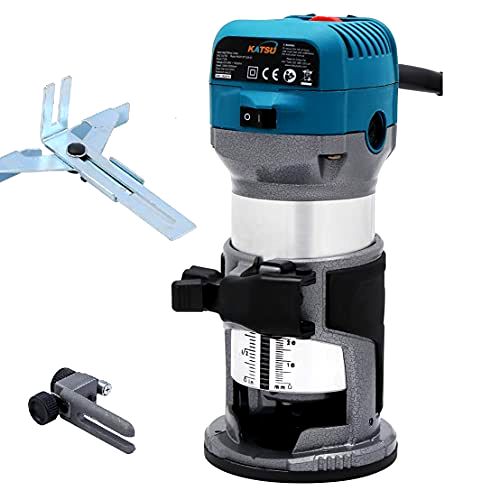
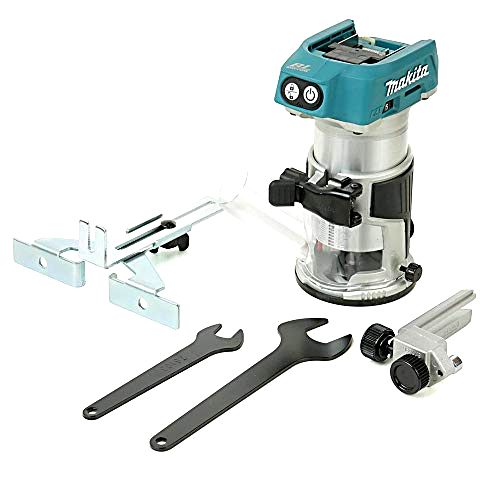
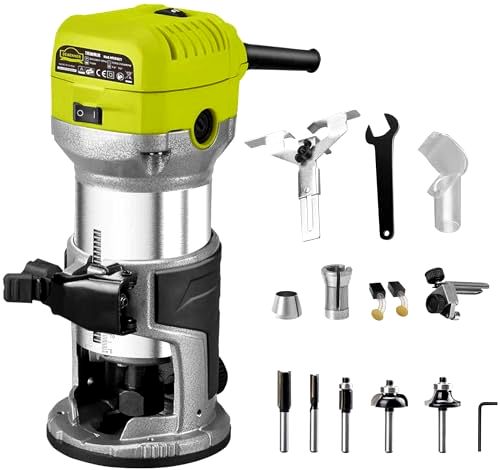
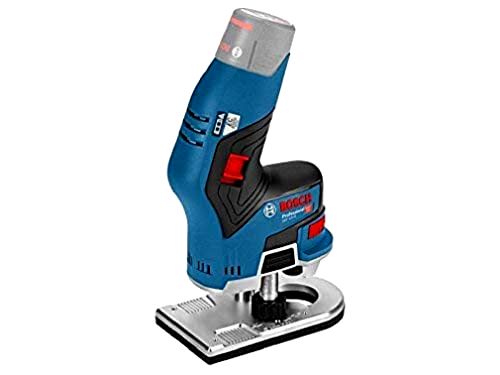
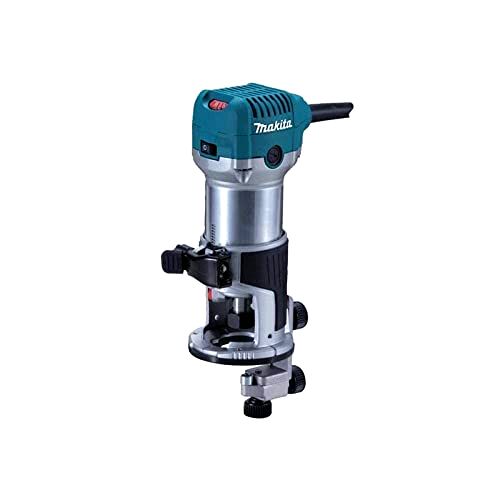
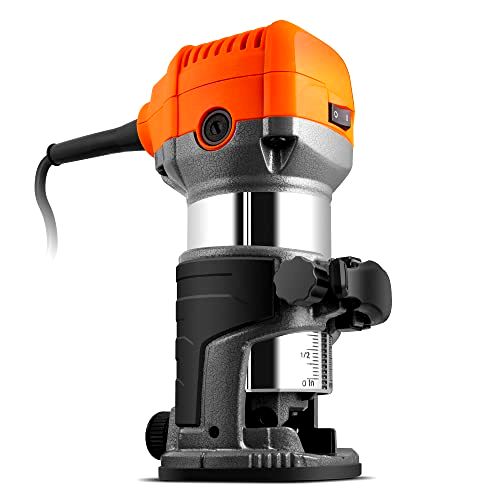
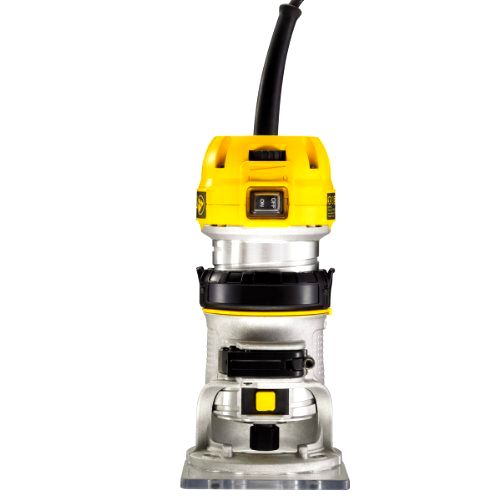
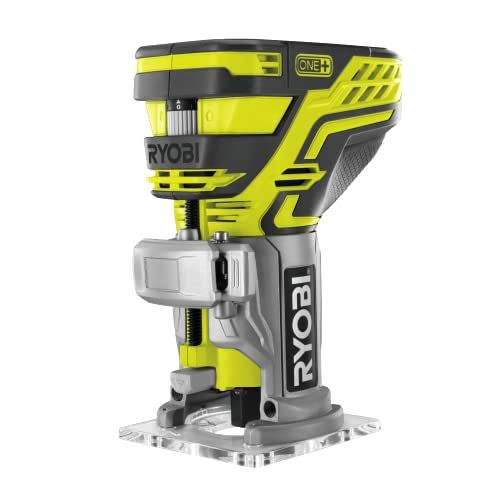

Share